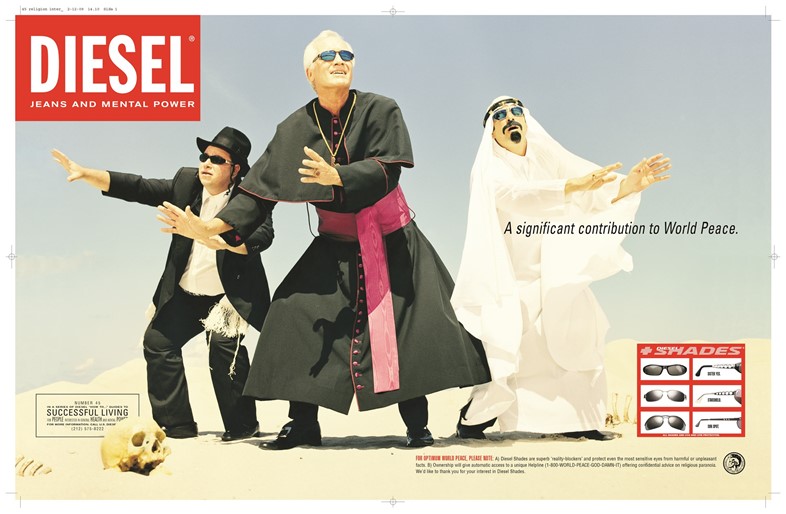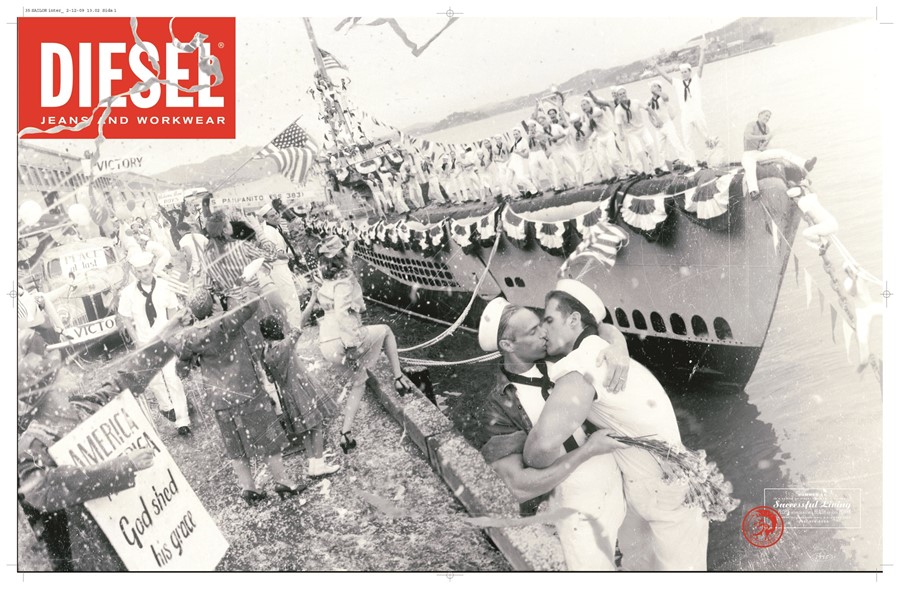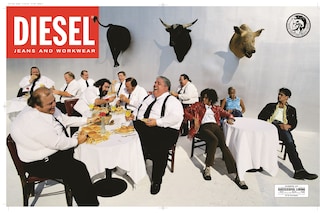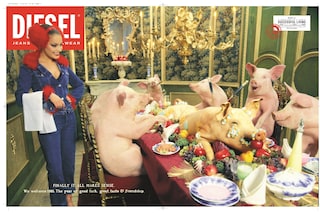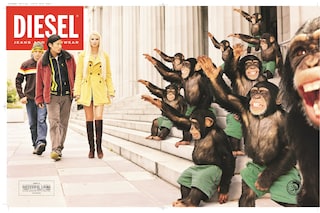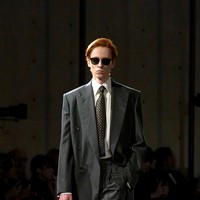Tackling politics, religion, sexuality and race, creative director Jocke Jonason talks us through the provocative campaigns he produced for Diesel
Two male sailors are locked in a kiss as their shipmates celebrate the end of WW2; a young man points a gun while text instructs parents on the importance of teaching kids to kill; a black man dives into a ‘whites only’ pool in an apartheid-divided South Africa. Believe it or not, these are all scenes depicted in the 90s campaigns of denim brand Diesel, who, over the course of the decade, created images which tackled religion, sexuality and race head-on.
Beginning in 1991, Jocke Jonason at the advertising agency Paradiset was the man brought in for the job, working with former marketing director and fellow Swede Johan Lindeberg on the images. Together, they confronted the kind of topics that companies today stay as far away from as possible – creating campaigns which, while controversial, demonstrated that serious subject matter could be tackled in a tongue-in-cheek way. Against the odds, they proved that the fashion campaign was a fitting canvas both for poking fun at the establishment and inspiring young generations to interrogate the world around them.
Jonason’s visuals went under the name “For Successful Living” – an idea the brand resurrected for its recent Terry Richardson-shot campaign. As they go on display at Stockholm’s Fotografiska Museet as Finally It All Makes Sense: Diesel Adverts 1991-2001, he reflects on these iconic campaigns.
How did these campaigns first come about?
Jocke Jonason: It started because Diesel hadn’t done any official advertising before – this was back in 1991. But what we could see as the future in communication and advertising, and what they had in terms of ideas for their company, didn’t exist then at all. The early 90s was quite a depressing time, the economy was bad and people were suffering – then we came up with this happy-go-lucky, political, completely wrong campaign. There was only really one denim brand in Europe at the time, Levi’s, which had about 75 per cent of the jean market, and then a couple of small brands. Diesel’s advertising (and the product, of course) changed the game – suddenly it wasn’t old America that mattered – all those kind of things became irrelevant after just a few seasons with this campaign.
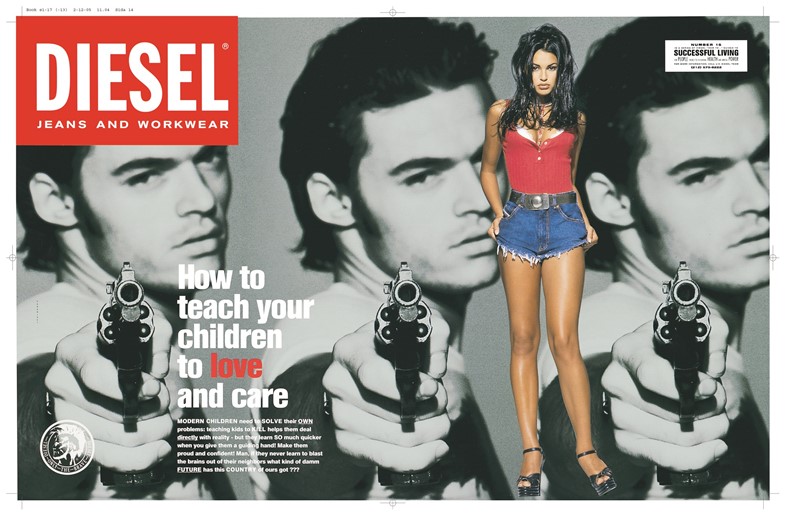
What kind of mission did you have?
Jocke Jonason: Well, I think the most important thing was that everybody said, ‘If you’re communicating with young people all over the world, they don’t want to read, they want a cool campaign with cool people’ and all of that crap. We said, ‘No, we’re going to do something that is totally opposite.’ We believe that young people, like everybody else, are interested in politics, in life, in discussing things – so we challenged people’s minds. What we made was provocative, funny, but also intellectual – we more or less tried to pick up on the conversation that was going on in society around us and make art of it. We knew that we were right, but in those days it was a risk. Still, it showed that, of course, everybody is interested in stuff that’s serious, as long as it is presented in a fun and cool way. It doesn’t have to be boring just because it’s serious. I think in terms of advertising, it changed the ways you can communicate with younger people.
There’s a historical element to some of the images, like with the moon landing and the man diving into the pool that’s supposed to be in South Africa. You were doing something so modern, why look back?
Jocke Jonason: Well, the point was not to look back, the point was to create another backdrop so we could talk about certain issues, so we came up with the idea of creating a campaign called historical moments. Diesel was obviously a new company where Levi’s, for instance, was an old, historical company, so we said, ‘OK, if we pretend that we actually existed before the Second World War, then we put ourselves into different situations, that’ll make it much more interesting.’ It makes it easier for us to talk about certain things and generate a lot of creative juice for ourselves.
“What we made was provocative, funny, but also intellectual – we more or less tried to pick up on the conversation that was going on in society around us and make art of it” – Jocke Jonason
What was the attitude of advertising at the time?
Jocke Jonason: I’d say it’s pretty much like it is today. The same cliches that we see all around us – sure, you can have a great photographer, but we’re back at square one. That’s why when you look at this campaign you feel that it’s different – that today you could actually take the ads that we did and put them straight into Dazed & Confused and it would work in the same way as they did in those years.
Did you ever feel like you went too far?
Jocke Jonason: A couple of times… not that we went too far or were too over-the-top, but the reaction was so strong that we said, ‘Right, next time we should take it a little bit more easy, talk about something that's a little bit more trivial.’ When we had the ad with the guy pointing a gun, the advertising director called me from New York and said, ‘We have to take it a little easier next time because there’s a big, big, big demonstration outside’ – I don’t remember what department store it was. So I was like, ‘OK, I understand.’ That particular ad has a strong message.
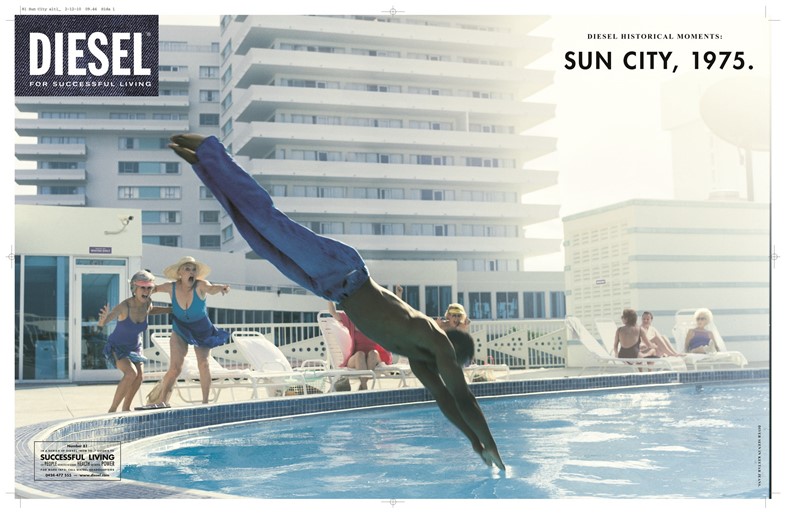
Was that the most controversial campaign?
Jocke Jonason: No, I wouldn’t say so.
What was?
Jocke Jonason: It depends on the country. In those days, if you take being gay for example, it’s not even controversial any more in most countries. But when we did the sailors with David LaChapelle in the mid-90s, the reaction in some countries… in some countries they can’t even touch the subject. So of course we got big reactions, but I think they created more interesting discussions than what you would call reactions, particularly negative reactions, people getting angry. Then there was no social media, so it was easier to start provocative conversations in media – if you do something that is just a little bit bold today, you can instantly have ten people create a huge storm online. It’s much more difficult for companies to be brave today. We didn’t have that problem.
“I’d rather be somebody’s shot of whiskey than everybody’s cup of tea” – Jocke Jonason
Do you think that companies should be braver now, or that people should be less sensitive?
Jocke Jonason: You will always have a couple of people who react in negative ways. In general, it’s just a very boring time at the moment, I think. People are afraid, companies are afraid, everybody’s into not taking risks instead of thinking about how to win. And that’s a huge difference. I’d rather be somebody’s shot of whiskey than everybody’s cup of tea.
Are there any that weren’t so popular?
Jocke Jonason: Some of the more interesting ones were the ones that maybe didn’t get so much press at the time, ones that nobody really liked. For example, the guy with the wheelchair on the beach, I think it was in, like, four or five magazines, but when I look at it today, it’s so simple and so different and it doesn’t scream, but maybe that’s why I like it. Those kind of things that in those days maybe didn’t evoke as much as much as something else, when you look at them now, I’m really proud we did those kind of pictures.
Finally It All Makes Sense: Diesel Adverts 1991-2001 is on show at Fotografiska, Stockholm until February 5, 2017
